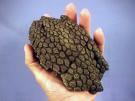
Dinosaur fossils
have been known about for millennia, though their
true nature was not recognized; the Chinese considered
them to be dragon bones, while
Europeans believed
them to be the remains of
giants and other creatures
killed by the Great Flood. The first dinosaur
species to be identified and named was Iguanodon,
discovered in 1822 by the English geologist Gideon
Mantell, who recognized similarities
between his fossils and the bones of modern
iguanas. Two years later, the Rev William Buckland,
professor of geology at Oxford University, became
the first person to describe a dinosaur in a
scientific journal — in this case Megalosaurus
bucklandii, found near Oxford.
The study of
these "great
fossil lizards" became of great
interest to European and American scientists,
and in 1842 the English paleontologist Richard
Owen coined
the term "dinosaur".
He recognized that the remains that had been
found so far —
Iguanodon, Megalosaurus and Hylaeosaurus —
had a number of features in common, so decided
to present them as a distinct
taxonomic group.
With the backing of Prince Albert of Saxe-Coburg-Gotha,
husband of Queen Victoria, Owen established
the Natural History Museum
in South Kensington,
London, to display the
national collection of dinosaur fossils and other biological and geological
exhibits.
In 1858, the first known
American dinosaur was
discovered in marl pits of the small town of Haddonfield,
New Jersey (although fossils had been found before,
their nature had not been identified). The creature
was named Hadrosaurus foulkii, after the town
and the discoverer, William Parker Foulke. It
was an extremely important find: Hadrosaurus was
the first nearly complete dinosaur skeleton ever
found and it was clearly a bipedal
creature. This
was a revolutionary discovery, as it had been
thought by most scientists that dinosaurs walked
on four feet like lizards.
Foulke's discoveries
sparked a dinosaur mania in the United States
which was exemplified by the fierce rivalry of
Edward Drinker Cope and Othniel Charles Marsh,
who each competed to outdo the other in finding
new dinosaurs in what came to be known as the
Bone Wars. Their feud lasted for nearly 30 years
and only ended in 1897 when Cope died after spending
his entire fortune in the dinosaur hunt. Marsh
won the contest by virtue of being better funded
through the US Geological Survey. Cope's
collection is now at the
American Museum of Natural History in New York, while Marsh's is displayed at the Peabody Museum of Natural History at Yale University.
Since then, the search for dinosaurs has been carried to every continent on Earth. This includes Antarctica, where the first dinosaur, a nodosaurid Ankylosaurus, was discovered on Ross Island in 1986, though it was 1994 before an Antarctic dinosaur, the Cryolophosaurus ellioti, was formally named and described in a scientific journal. Current "hotspots" include southern South America (especially Argentina) and China, which has produced many exceptionally well-preserved feathered dinosaurs.